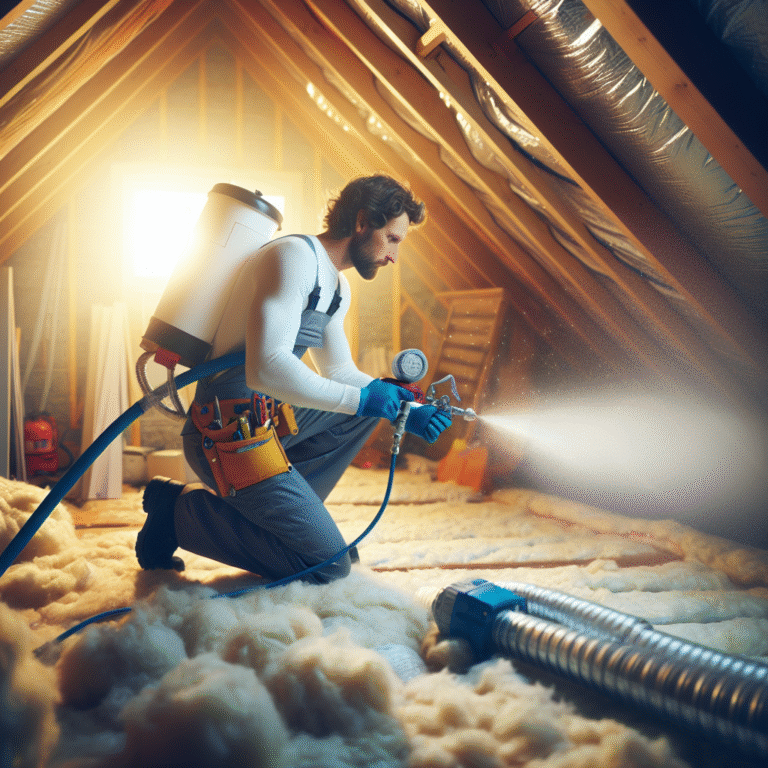-
Table of Contents
Seal out pests and keep your home cozy with blown-in insulation.
“Protect your home from pesky rodents with blown-in insulation. Visit texasinsulationsolution.com to learn more and schedule an appointment today!”
Introduction
Blown-in insulation is a popular method of insulating homes, providing numerous benefits such as energy efficiency and noise reduction. However, one lesser-known advantage of blown-in insulation is its ability to keep rodents out of your home. In this article, we will explore how blown-in insulation can act as a barrier against rodents and help protect your home from these unwanted pests.
5 Ways Blown-In Insulation Can Protect Your Home from Rodents
Rodents are a common problem that many homeowners face. These small creatures can cause significant damage to your home, from chewing through wires to leaving droppings and urine that can lead to health hazards. Not only are they a nuisance, but they can also pose a threat to the structural integrity of your home. Fortunately, there are ways to prevent rodents from entering your home, and one effective method is through blown-in insulation.
Blown-in insulation, also known as loose-fill insulation, is a type of insulation that is blown into the walls, attic, or crawl space of a home. It is made up of small particles of materials such as fiberglass, cellulose, or mineral wool. This type of insulation is not only beneficial for keeping your home warm in the winter and cool in the summer, but it can also act as a barrier against rodents. Here are five ways blown-in insulation can protect your home from rodents.
1. Seals Entry Points
One of the main ways that rodents enter homes is through small cracks and openings in the walls, roof, or foundation. These openings may seem insignificant to us, but to a rodent, they are an invitation to come inside. Blown-in insulation can help seal these entry points, making it difficult for rodents to enter your home. The small particles of insulation can fill in even the tiniest of gaps, creating a barrier that rodents cannot penetrate.
2. Deters Nesting
Rodents are always on the lookout for a warm and cozy place to build their nests. Unfortunately, attics and crawl spaces are the perfect spots for them to do so. However, blown-in insulation can act as a deterrent for nesting. The particles of insulation are not only difficult for rodents to move around, but they can also be irritating to their skin and eyes. This makes it less appealing for them to create a nest in your home.
3. No Food Source
Rodents are attracted to homes because they provide a steady supply of food. However, blown-in insulation does not provide any food source for them. Unlike other types of insulation, such as foam or batt, blown-in insulation is not made of organic materials that rodents can feed on. This means that they are less likely to stick around in your home if there is no food source for them.
4. No Hiding Places
In addition to food, rodents also need a place to hide and feel safe. Blown-in insulation can eliminate these hiding places. The particles of insulation are tightly packed together, leaving no room for rodents to hide. This makes it easier for homeowners to spot any signs of rodent activity and take action before it becomes a bigger problem.
5. Non-Toxic
Some homeowners may be concerned about using toxic methods to keep rodents out of their homes. Blown-in insulation is a non-toxic option that is safe for both humans and pets. It does not contain any harmful chemicals or pesticides, making it an environmentally friendly choice. This also means that you do not have to worry about any potential health hazards for your family.
In conclusion, blown-in insulation is not only an effective way to keep your home comfortable, but it can also act as a barrier against rodents. By sealing entry points, deterring nesting, eliminating food sources and hiding places, and being non-toxic, blown-in insulation can help protect your home from these pesky creatures. If you are dealing with a rodent problem or want to prevent one from occurring, consider investing in blown-in insulation for your home.
The Top Benefits of Using Spray Foam Insulation to Keep Rodents Away
When it comes to protecting your home from unwanted pests, insulation may not be the first thing that comes to mind. However, the type of insulation you choose can play a significant role in keeping rodents out of your home. Blown-in insulation, also known as spray foam insulation, is a popular choice for homeowners looking to keep rodents at bay. In this article, we will explore the top benefits of using blown-in insulation to keep rodents away from your home.
First and foremost, blown-in insulation creates a tight seal in your home, making it difficult for rodents to enter. Unlike traditional insulation materials such as fiberglass or cellulose, blown-in insulation is applied as a liquid and expands to fill any gaps or crevices in your walls, floors, and ceilings. This creates a seamless barrier that rodents cannot easily penetrate. As rodents are known for their ability to squeeze through small openings, this tight seal is crucial in keeping them out of your home.
Furthermore, blown-in insulation is made of a material that is unappealing to rodents. Unlike other insulation materials that may contain organic materials such as paper or cotton, blown-in insulation is primarily made of polyurethane foam. This material is not a food source for rodents, making it less likely for them to be attracted to your home. Additionally, blown-in insulation does not contain any chemicals or additives that may be harmful to rodents, making it a safe and humane option for keeping them away.
Another benefit of blown-in insulation is its durability. Unlike traditional insulation materials that can break down over time, blown-in insulation maintains its shape and effectiveness for many years. This means that once it is installed, you can enjoy long-term protection against rodents without having to worry about replacing or replenishing the insulation. This not only saves you time and money but also ensures that your home remains protected from rodents for an extended period.
In addition to keeping rodents out, blown-in insulation also helps to regulate the temperature in your home. This type of insulation has a high R-value, which is a measure of its thermal resistance. This means that it is highly effective in preventing heat transfer, keeping your home warm in the winter and cool in the summer. As rodents are attracted to warm and cozy environments, maintaining a consistent temperature in your home can help to deter them from entering.
Moreover, blown-in insulation is an eco-friendly option for keeping rodents away. As it is made of polyurethane foam, it does not contain any harmful chemicals or pollutants that can harm the environment. Additionally, blown-in insulation is energy-efficient, meaning that it can help to reduce your carbon footprint and lower your energy bills. By choosing blown-in insulation, you are not only protecting your home from rodents but also doing your part in preserving the environment.
In conclusion, blown-in insulation offers numerous benefits when it comes to keeping rodents out of your home. Its ability to create a tight seal, its unappealing material, durability, temperature regulation, and eco-friendliness make it a top choice for homeowners looking to protect their homes from unwanted pests. If you are dealing with a rodent infestation or want to prevent one from occurring, consider using blown-in insulation as a long-term solution. With its many advantages, it is a worthwhile investment that will provide you with peace of mind and a rodent-free home.
Why Durable Blown-In Insulation is the Best Choice for Rodent Prevention in Your Home
When it comes to keeping your home safe and comfortable, insulation is a crucial factor. Not only does it help regulate the temperature inside your home, but it also plays a significant role in keeping pests and rodents out. While there are various types of insulation available, blown-in insulation has proven to be the most effective in preventing rodents from entering your home.
So, what exactly is blown-in insulation? It is a type of insulation that is made up of small particles of materials such as fiberglass, cellulose, or mineral wool. These particles are blown into the walls, attic, or crawl spaces of your home using a special machine. The result is a dense layer of insulation that fills every nook and cranny, providing excellent coverage and preventing any gaps where rodents can enter.
One of the main reasons why blown-in insulation is the best choice for rodent prevention is its durability. Unlike other types of insulation, blown-in insulation does not compress over time. This means that it maintains its density and effectiveness in keeping rodents out for many years. As rodents are known to chew through materials, having a durable insulation that they cannot easily damage is crucial in keeping them out of your home.
Moreover, blown-in insulation is also resistant to moisture, which is another factor that attracts rodents. When insulation gets wet, it becomes a breeding ground for mold and mildew, which can attract rodents looking for a warm and damp place to nest. With blown-in insulation, the particles are tightly packed, making it difficult for moisture to penetrate and cause any damage. This not only keeps rodents out but also helps prevent any potential health hazards caused by mold and mildew.
Another advantage of blown-in insulation is its ability to fill small and hard-to-reach spaces. Rodents are known to squeeze through tiny openings, making it challenging to keep them out. However, with blown-in insulation, the particles can be blown into even the tiniest of spaces, leaving no room for rodents to enter. This makes it an effective solution for preventing rodents from entering your home through gaps in the walls, attic, or crawl spaces.
Furthermore, blown-in insulation is also environmentally friendly. It is made from recycled materials, making it a sustainable choice for insulation. This means that not only are you keeping rodents out of your home, but you are also contributing to a greener environment. Additionally, blown-in insulation is also energy-efficient, helping you save on your heating and cooling costs in the long run.
In conclusion, blown-in insulation is the best choice for rodent prevention in your home due to its durability, moisture resistance, ability to fill small spaces, and eco-friendliness. It provides a long-term solution for keeping rodents out and maintaining a comfortable and safe living environment. If you are looking to upgrade your home’s insulation, consider blown-in insulation for its many benefits, including keeping pesky rodents at bay.
Q&A
1. What is blown-in insulation?
Blown-in insulation is a type of insulation that is installed by blowing loose fibers or particles into the walls, attic, or other areas of a home. It is typically made of materials such as fiberglass, cellulose, or mineral wool.
2. How does blown-in insulation help keep rodents out of a home?
Blown-in insulation helps keep rodents out of a home by filling in any gaps or cracks in the walls or attic where rodents could potentially enter. The dense and compact nature of blown-in insulation makes it difficult for rodents to chew through or move around, acting as a barrier to keep them out.
3. Are there any other benefits of blown-in insulation besides keeping rodents out?
Yes, there are several other benefits of blown-in insulation. It can help improve energy efficiency by reducing air leakage and keeping the home at a more consistent temperature. It also helps reduce noise levels from outside and can improve indoor air quality by reducing the amount of dust and allergens that enter the home. Additionally, blown-in insulation is a cost-effective and environmentally friendly option for insulating a home.
Conclusion
In conclusion, blown-in insulation is an effective way to keep rodents out of your home. The tightly packed insulation creates a barrier that is difficult for rodents to penetrate, making it less likely for them to enter your home. Additionally, the insulation material is not appealing for rodents to nest in, further deterring them from entering your home. By properly insulating your home, you can not only save on energy costs but also prevent unwanted rodent infestations. It is a simple and cost-effective solution to keep your home rodent-free.




